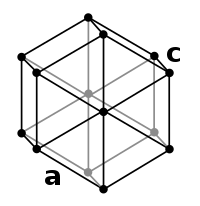
Photo from wikipedia
Biohydrogen (BioH2) is considered a promising fuel characterized by the high energetic content per unit of mass, easy electricity production by fuel cells (FCs), which generate water as the only… Click to show full abstract
Biohydrogen (BioH2) is considered a promising fuel characterized by the high energetic content per unit of mass, easy electricity production by fuel cells (FCs), which generate water as the only by-product. The objective of this study was to evaluate the performance of a continuous multiple tube reactor (CMTR) with the inner surface of the tubes as worm thread in the continuous production of hydrogen. The useful volume of the reactor was 1065.5 mL. The reactor was operated under anaerobic conditions, continuous upflow and kept in an air-conditioned chamber at 25 oC. Two assays were conducted: E1: COD of 2 g L-1, hydraulic retention time (HRT) of 2 h and organic loading rate (OLR) of 24 g L-1d-1; E2: COD - 4 g L-1, HRT – 2h, OLR - 48 g COD L-1d-1. The monitoring to evaluate the reactor performance included chemical oxygen demand (COD) removal efficiency (ERCOD, %); sucrose conversion efficiency (ECsuc, %); biogas flow rate (Qbiogas, in mL h-1); hydrogen molar flow (MHFR, in mmol H2 h-1), hydrogen yield (HY, in mol H2 mol-1 sucrose) and volumetric hydrogen production rate (VHPR, in mL H2 L-1 d-1). The CMTR presented stability in H2 production, which allowed the production for long operation periods. The adaptation of the inner surface of the tubes as worm thread improved the performance of the system, which indicates that the biomass retention was sufficient to attend the conditions of the system.
Journal Title: Chemical engineering transactions
Year Published: 2019
Link to full text (if available)
Share on Social Media: Sign Up to like & get
recommendations!